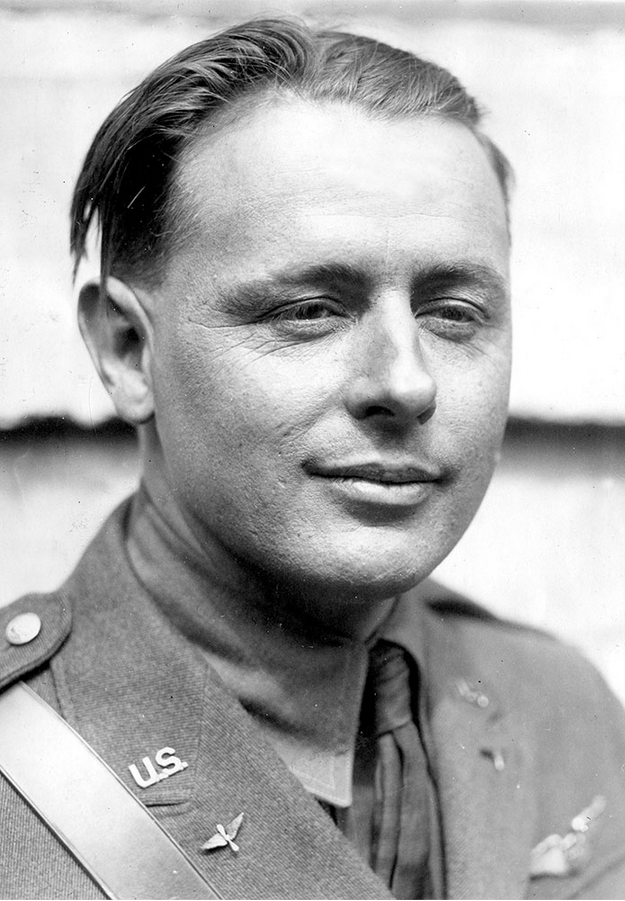
9 May 1932: At McCook Field, Ohio, Captain Albert Francis Hegenberger, Air Corps, United States Army, flew the very first solo instrument approach and landing, using a system which he had developed. The Hegenberger system, which was adopted by both civil and military aviation authorities, used a series of non-directional radio beacons (NDB) and marker beacons on the ground, along with a radio-compass and other gyroscopic instruments and radio receivers aboard the aircraft, a Consolidated NY-2 biplane.
Hegenberger had located one NDB 1,500 feet (457 meters) from the airfield boundary, and another at 1½ miles (2.4 kilometers). They were aligned with the runway centerline. Both had marker beacons which would signal that the airplane was directly overhead. The radio compass aboard the airplane would indicate the direction of the NDB relative to the airplane and lights would illuminate when it passed over the marker beacons. When the airplane was heading directly toward the NDB, the needle pointed to zero.
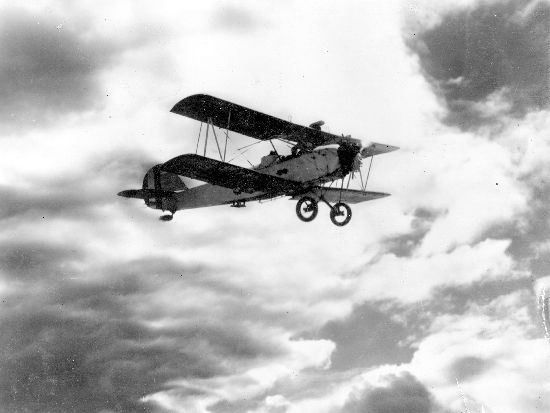
Captain Hegenberger turned toward the inner NDB from a distance of 50 miles (80 kilometers). He passed over it at a pre-planned altitude. When the lights on the instrument panel came on indicating that he was directly over the inner marker beacon, he turned toward the outer NDB. Crossing the outer marker, Hegenberger made a 180° turn back toward the inner NDB and began his descent. As he passed over the inner NDB again, he reduced engine power and placed the airplane in a landing attitude and waited for it to touch down on the runway.
This flight was the first solo blind instrument flight, approach and landing. (Lt. James H. Doolittle had made a blind instrument flight in 1929, but he carried a safety pilot aboard.) For his accomplishment, Captain Hegenberger was awarded an oak leaf cluster (a second award) for his Distinguished Flying Cross, and received the Collier Trophy, an annual award for the greatest achievement in aeronautics in America.
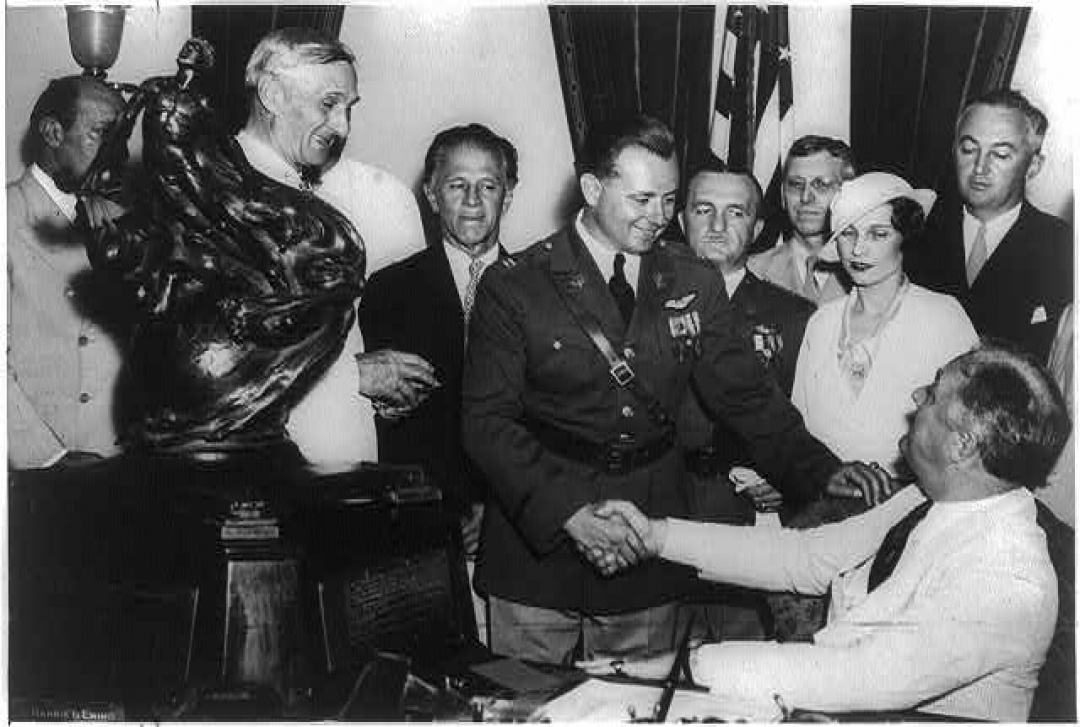
Within one week, the Civil Aeronautics Board created a new pilot rating and required that all commercial pilots demonstrate proficiency in instrument flight. In 1935, the CAB adopted Hegenberger’s system and ordered equipment installed at all major airports between New York and Los Angeles.
The Air Corps Newsletter reported the event:
FIRST SOLO BLIND FLIGHT A SUCCESS
By Lieut. Joseph S. Edgerton, Air Reserve.
ANOTHER milestone in aviation progress was reached a few days ago when Capt. Albert F. Hegenberger, Army Air Corps, made the first “blind” solo flight, seeing nothing but the instruments before him from take-off to landing. If the elements which made Hegenberger’s achievement possible can be applied to air transport operations, one of the greatest foes of aviation can be whipped.
Dense ground fog on an air transport today brings all flying to a halt. As long as the fog holds no mail or passengers move by air. The only solution is artificial fog dispersion or “blind landings” through the fog. Fog dispersion so far is impracticable, if not impossible. Blind landings, apparently, form the practicable solution.
Until Captain Hegenberger’s solo flight, no man had landed “blind” and alone though “Jimmy” Doolittle three years ¹ ago landed blind with a check pilot aboard to take over the controls in case Doolittle’s skill failed or his calculations went awry.
Hegenberger used radio to guide him into the field, to mark for him the point at which to begin his glide and to warn him when he neared the field boundary. He employed a super-sensitive altimeter to indicate his altitude above the landing area. Other flight instruments were normal, including artificial horizon, gyro compass, radio compass and standard flight instruments. The flight was made at Dayton, Ohio, home of the Air Corps Materiel Division, where Captain Hegenberger is stationed as navigation officer.
Modest to a fault, quiet and unassuming, Captain Hegenberger is a brilliant figure in aviation, though seldom in the limelight. he first came to public fame when he flew from California to Hawaii with Lieut. Lester Maitland, ² the first Pacific flight. He is regarded as one of the world’s three foremost aerial navigators.
So retiring is Hegenberger that the world remained for many days in the dark as to his achievement. Captain Hegenberger was on the high seas, enroute to Rome to attend the first international meeting of ocean flyers when the story of his success was given to the world by F. Trubee Davision, Assistant Secretary of War for Aeronautics, who learned of the flight from Hegenberger’s official report.
Of the crucial moment when Captain Hegenberger, alone in his swiftly moving plane, felt his way toward the surface of the earth which he could not see, he has little to say in his report. It is difficult for the layman to put himself in Hegenberger’s position during that moment. To get something of the idea, imagine yourself driving in an automobile. The windows are all curtained so that you can get no glimpse of anything outside the car, no sky, no road – nothing but the blank curtains and the instruments. You have a radio direction finder, with a little arrow showing when you deviate to the right or left of a given course. You are driving at 50 miles an hour across an open field. At the far side of the field is a great yawning chasm of appropriate depth – say something like the Grand Canyon. There is but one avenue of safety, a very narrow bridge. If you miss the bridge, curtains. A radio beacon is guiding you to the bridge and your only indication is the little pointer. You may not slacken speed but you must hit the bridge precisely.
Your problem, however, would be much simpler than Hegenberger’s. Gravity would hold you on the ground and you wouldn’t have to worry about that. You would have to worry only about whether you were too far to the left or right. Hegenberger had to worry, not only about whether he was to the right or left of the runway, but also whether he was too high or too low and whether he was actually over the landing field or over some other place or terrain not at all suitable for the landing of airplanes.
It must have been with a feeling of exquisite relief that he felt the wheels touch the ground and the plane roll to a stop safely. Of this feature of the experiment, however Capt. Hegenberger has only this to say: “The radio transmitters mark the field boundary and all you have to do is just fly along the ground, take things gently and easily, and when you feel it hit – well, just ease back on the stick.”
A magnificent flight, and one worthy of a large and imposing monument on the green fields of aeronautical progress. – Washington STAR
Ed. Note:
According to the announcement of Mr. Davidson regarding this first solo Blind Flight, Captain Hegenberger took off and, after flying for five minutes, landed solely by the air of the instruments on the panel in front of him without once seeing outside of the cockpit. This successful flight was the seventh in a series of nine attempts. During the first three flights, observers were carried in the plane who knew nothing of flying. On the seventh flight, Capt. Hegenberger took off alone, made two 180-degree turns and landed at the take-off point. He was guided during this flight by the various instruments already enumerated. One the ground were three radio sets, two of which were of obsolescent type. The cockpit occupied by Captain Hegenberger had a shielded cover which cut off all view outside the plane. He first tuned in on a transmitter distant from the field to simulate cross-country flying. After executing the first 180-degree turn, he tuned in first on a portable transmitter placed 1,000 feet from the border of the field and then on another a mile and a half away. Although flying away from the field he was able by lining up the two radio transmitters to ascertain the correct flight path on which to return for his landing. Executing his second 180-degree turn at a height of 1,000 feet, he began gliding down as he headed for the mile-and-a half station.
Captain Hegenberger explained that for regular blind landings certain refinements of equipment will be needed. He expressed the desire to start a graduate class of Air Corps officers for training in blind flight take-offs and landings. This Army pilot of Hawaiian Flight fame is now on duty as navigation officer at the Materiel Division, Wright Field, Dayton, Ohio. His blind flying experiments are a continuation of those carried out under the Daniel Guggenheim Fund for the Promotion of Aeronautics by former Lieut. James H. Doolittle, now a Major in the Air Corps Reserve, and as brilliant a figure in commercial aviation as he was while actively connected with the Air Corps. On September 24, 1929, Major Doolittle first demonstrated to the world the possibility of landing an airplane by instruments alone. He carried a check pilot to take over the controls in case of emergency.
It may be stated that Captain Hegenberger is a pioneer in blind flying, for nearly nine years ago, on September 6, 1923, he flew the greater part of the journey from Dayton to Boston completely out of sight of land. Of course, there were no hooded cockpits in those days but, so far as vision of the ground was concerned, Captain Hegenberger and his passenger, Mr. Bradley Jones, Navigation Engineer at McCook Field, were not much better off that the present day airman piloting a covered wagon, aerial type.
Despite unfavorable weather conditions, they took off from McCook Field in a DeH at ten o’clock and landed at Boston Airport 7 hours and 25 minutes later. The sky was obscured by clouds which stretched from 300 to 7,000 feet altitude. After sighting Ohio State Univeriity at Columbus, the clouds became so dense that the flyers climbed above them and found themselves in clear sunlight little above 10,000 feet. A solid layer of clouds stretched beneath them. Not a glimpse of a land mark was obtained for a number of hours. The entire State of Pennsylvania was passed over without their obtaining a glimpse of it. Flying by instruments alone, Captain Hegenberger, at about 3:40 p.m., estimated that he should be close to the Hudson River, so he descended through the clouds and crossed this body of water not five minutes later. The remainder of the journey to Boston was made under the clouds. The successful termination of this flight demonstrated the efficiency of air navigation instruments even in those early days of Army aviation.
—Air Corps News Letter, Vol. XVI, No. 6, 26 May 1932, at pages 207–208

Albert Francis Hegenberger was born 30 September 1895 at Boston, Massachusetts, United States of America. He was the second of five children of Alphonse Frederick Hegenberger, a clerk and immigrant from Bavaria, and Emma Amanda Buegler Hegenberger, of Switzerland.
In 1913 Hegenberger entered the Massachusetts Institute of Technology (M.I.T.), Cambridge, Massachusetts, as a student of aeronautical engineering.
Following the United States’ entry into World War I, Albert F. Hegenberger enlisted as a private in the Aviation Section, Signal Corps, United States Army, 14 September 1917. He was assigned to the School of Military Aeronautics at M.I.T., graduating in December 1917. After flight training at Ellington Field, Houston, Texas, Hegenberger was commissioned a second lieutenant, Aviation Section, Signal Officers Reserve Corps, 6 April 1918. This commission was vacated 19 September 1920, and he was appointed a second lieutenant, Air Service, retroactive to 20 July 1920. He was promoted to the rank of first lieutenant, effective that that same date.
In October 1918, Second Lieutenant Hegenberger returned to M.I.T., and entered the School of Aeronautical Engineering. He graduated in February 1919.
Lieutenant Hegenberger married Miss Louise B. Berchtold in 1919. They would have two sons, Albert F., Jr., born in 1920, and Robert F., born in 1924.
In October 1923, 1st Lieutenant Hegenberger was assigned to the 72nd Bombardment Squadron, 5th Composite Squadron, at Luke Field on the Island of Oahu, Territory of Hawaii. The squadron was equipped with the DH-4 and the twin-engine Martin NBS-1 bomber. In March 1925, Lieutenant Hegenberger was transferred to the 23rd Bombardment Squadron, 5th Composite Group.
Lieutenant Hegenberger was next assigned as chief of the Equipment Branch, Material Division, at McCook Field, Dayton Ohio. He served in that position from October 1926 until June 1927, when became chief of the Instrument and Navigation Unit.
At 7:09 a.m., Pacific Daylight Time, 28 June 1927, 1st Lieutenant Lester J. Maitland and 1st Lieutenant Albert F. Hegenberger, Air Service, United States Army, took off from Oakland Municipal Airport, California, aboard an Atlantic-Fokker C-2, serial number A.S. 26-202, Bird of Paradise. Their destination was Wheeler Field, Honolulu, Territory of Hawaii, 2,407 miles (3,874 kilometers) across the Pacific Ocean.
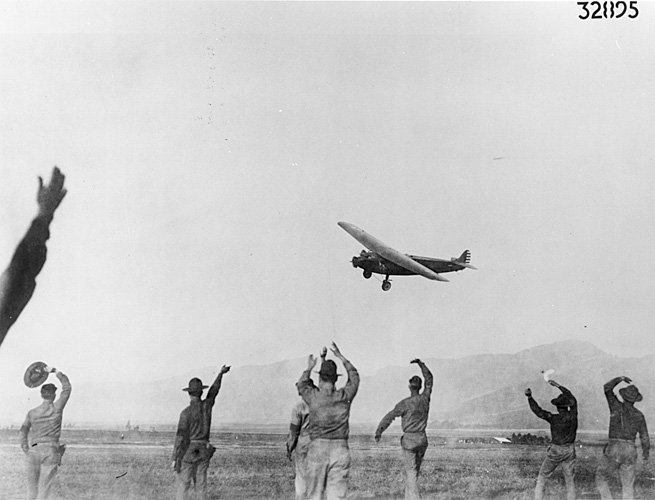
After 25 hours, 50 minutes of flight, Bird of Paradise landed at Wheeler Field, 6:29 a.m., local time, 29 June 1927. It had completed the first Transpacific Flight.
For their achievement, both officers were awarded the Distinguished Flying Cross. They were also awarded the Mackay Trophy for the most meritorious flight of the year.
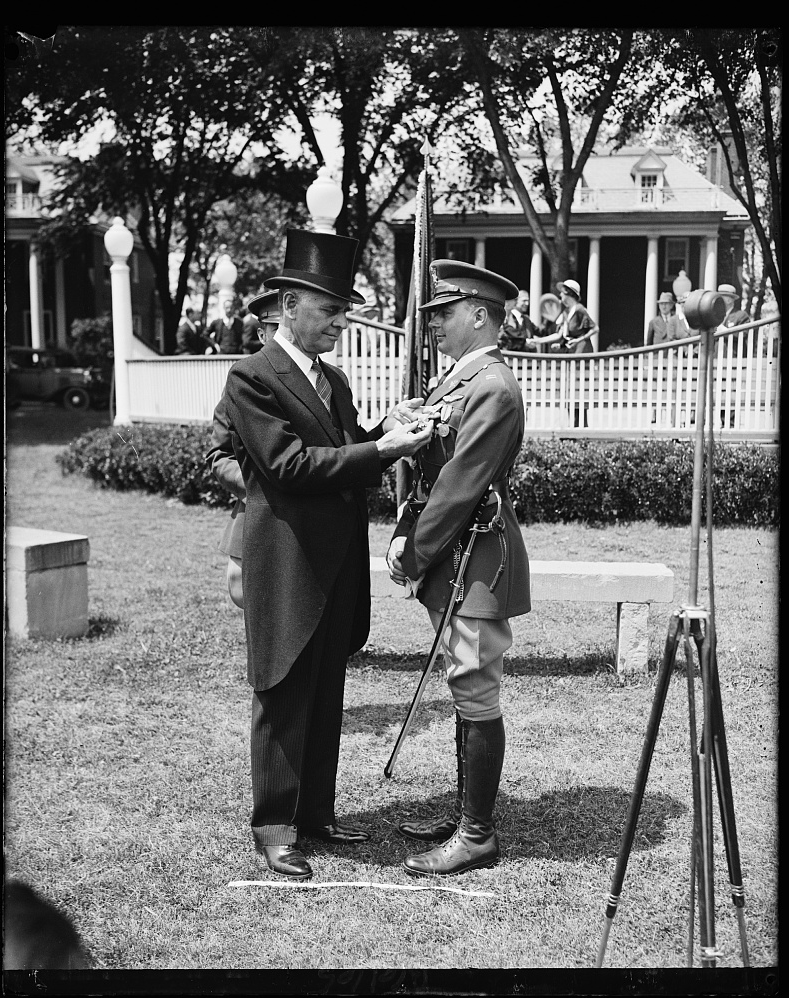
1st Lieutenant Hegenberger continued in his technical assignments at McCook and Wright Fields. On 3 January 1932, he was promoted to the rank of captain.
Mrs. Hegenberger died 7 August 1933.
In August 1935, Captain Hegenberger was assigned to the 30th Bombardment Squadron at Rockwell Field, San Diego, California. The squadron moved to March Field, near Riverside, California, and transitioned to the Martin B-10. Captain Hegenberger was advanced to the rank of major (temporary), 2 October 1935.
On 22 July 1937, Major Hegenberger married Ms. Jewel Lilly Van Houten (née Jewel Lilly Baker) at Detroit, Michigan.
From August 1937 to June 1939, Major Hegenberger was assigned to the Air Corps Tactical School, Maxwell Field, Montgomery, Alabama. Upon graduation, he was assigned to the 5th Bombardment Group at Hickam Field, Honolulu, Territory of Hawaii. The 5th was equipped with Keystone B-3 and B-4 bombers.
Major Hegenberger was appointed operations officer of the 18th Wing at Hickam, and then in November 1940, became assistant chief of staff for operations of the Hawaiian Air Force, headquartered at Fort Shafter, near Honolulu. Hegenberger was promoted to lieutenant colonel (temporary), on 30 December 1940. This rank became permanent 18 December 1941.
In April 1941, Lieutenant Colonel Hegenberger took command of the 11th Bombardment Group. The group was equipped with Douglas B-18 Bolo, but began receiving Boeing B-17 Flying Fortresses the following month.
Hegenberger was promoted to colonel (temporary), 5 January 1942. He took command of 18th Bombardment Group and Seventh Bomber Command. He was appointed Colonel, Army of the United States (A.U.S.), 8 June 1942. Returning to the continental United States, Colonel Hegenberger became assistant chief of staff for operations, Second Air Force, and commanding officer, II Bomber Command, at Fort George Wright, Spokane, Washington. In October 1942, Colonel Hegenberger took command of the 21st Bombardment Wing, based at Smoky Hill Army Air Field, Salina, Kansas, and later, Topeka Army Air Field, Topeka, Kansas.
Colonel Hegenberger was promoted to the rank of brigadier general, A.U.S., 18 September 1943. In January 1944, he was appointed Chief of Staff, Second Air Force, at Colorado Springs Army Air Field, Colorado Springs, Colorado.
The following year, January 1945, Brigadier General Hegenberger became Chief of Staff, Fourteenth Air Force, based at Chunking, China.
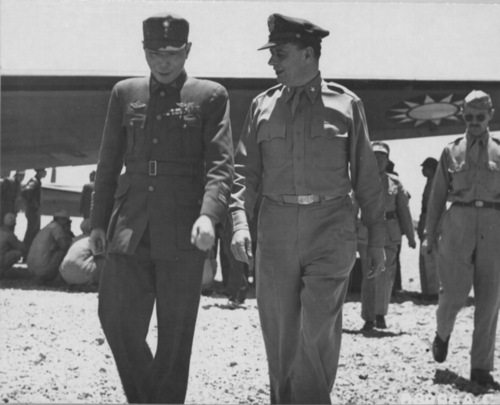
Hegenberger became commanding general, Tenth Air Force, also based in China, in August 1945. He was promoted to major general, A.U.S., 7 September 1945. From December 1945 to July 1946, Major General Hegenberger served at Headquarters Army Air Forces. He was then assigned to Pacific Air Command, United States Army (PACUSA), in Japan. He assumed command of the 1st Air Division, Kadena Army Air Base, Okinawa, in July 1946.
In December 1947, Hegenberger was assigned to the Weapons Group, Headquarters, U.S. Air Force. He then served on the staff of the Assistant Deputy Chief of Staff, Operations, for Atomic Energy. On 19 February 1948, Hegenberger’s previous rank of brigadier general, United States Air Force, became permanent, with date of rank retroactive to 19 September 1943. (He continued in the temporary rank of major general.)
Major General Hegenberger retired from the U.S. Air Force on 31 August 1949 after nearly 32 years of military service. During his career, he was awarded the Distinguished Service Medal, Legion of Merit, Distinguished Flying Cross with one oak leaf cluster (two awards), World War I Victory Medal, American Defense Service Medal, American Campaign Medal, World War II Victory Medal, Asiatic-Pacific Campaign Medal; Order of the Cloud and Banner (Republic of China); and Grande Ufficiale dell’Ordine della Corona d’Italia (Grand Officer, Order of the Crown of Italy).
Major General Albert Francis Hegenberger, United States Air Force (Retired) died at Goldenrod, Florida, 31 August 1983, at the age 87 years. He was buried at All Faiths Memorial Park, Casselbury, Florida.
¹ 24 September 1929. The check pilot was Lieutenant Benjamin Scovill Kelsey. Please see TDiA at: https://www.thisdayinaviation.com/24-september-1929/
² 28–29 June 1927. Please see TDiA at: https://www.thisdayinaviation.com/28-29-june-19/
© 2025, Bryan R. Swopes
Mr. Swopes…
Love the site. lots of good historical tidbits. I was looking for some addition information on an incident you had posted. Some commenters seem to supply some great info, but had some particular questions and the comments were closed. Your site seems like a great source for my question. Please contact me. Thanks.
Another great story. minor typo though “. He assumed assumed command of the 1st Air Division, Kadena Army Air Base, Okinawa, in July 1946.”
Thanks, Eric. That was about 0130 this morning. :/
I’m really good at catching other’s mistakes and missing my own 😉
What a great, informative story. Thanks for sharing. The masochist in me misses flying NDB approaches. My sadistic inner-self misses instructing students how to fly an NDB approach 😉
I actually enjoyed NDB approaches, too. 🙂
I finally found out the significance of Hegenberger Road leading into OAK. Thanks for a great article.
My partner and I built a display of the Doolittle panel for the Niagara Aerospace Museum.
Questions:
1. If Doolittle had chosen to fly solo, could he have accomplished what Hegenberger did?
2. What aircraft did Hegenberger use?